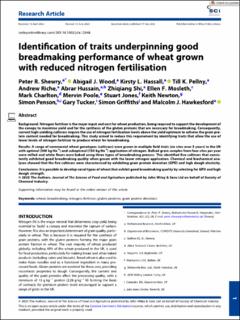| dc.contributor.author | Shewry, Peter R. | |
| dc.contributor.author | Wood, Abigail J. | |
| dc.contributor.author | Hassall, Kirsty L. | |
| dc.contributor.author | Pellny, Till K. | |
| dc.contributor.author | Riche, Andrew | |
| dc.contributor.author | Hussain, Abrar | |
| dc.contributor.author | Shi, Zhiqiang | |
| dc.contributor.author | Mosleth, Ellen Færgestad | |
| dc.contributor.author | Charlton, Mark | |
| dc.contributor.author | Poole, Mervin | |
| dc.contributor.author | Jones, Stuart | |
| dc.contributor.author | Newton, Keith | |
| dc.contributor.author | Penson, Simon | |
| dc.contributor.author | Tucker, Gary | |
| dc.contributor.author | Griffithsj, Simon | |
| dc.contributor.author | Hawkesford, Malcolm J. | |
| dc.date.accessioned | 2023-08-22T11:39:43Z | |
| dc.date.available | 2023-08-22T11:39:43Z | |
| dc.date.created | 2023-08-17T10:21:24Z | |
| dc.date.issued | 2023 | |
| dc.identifier.citation | Journal of the Science of Food and Agriculture. 2023, 1-9. | |
| dc.identifier.issn | 0022-5142 | |
| dc.identifier.uri | https://hdl.handle.net/11250/3085245 | |
| dc.description.abstract | Background: Nitrogen fertiliser is the major input and cost for wheat production, being required to support the development of the canopy to maximise yield and for the synthesis of the gluten proteins that are necessary for breadmaking. Consequently, current high-yielding cultivars require the use of nitrogen fertilisation levels above the yield optimum to achieve the grain protein content needed for breadmaking. This study aimed to reduce this requirement by identifying traits that allow the use of lower levels of nitrogen fertiliser to produce wheat for breadmaking. Results: A range of commercial wheat genotypes (cultivars) were grown in multiple field trials (six sites over 3 years) in the UK with optimal (200 kg Ha-1) and suboptimal (150 kg Ha-1) application of nitrogen. Bulked grain samples from four sites per year were milled and white flours were baked using three types of breadmaking process. This identified five cultivars that consistently exhibited good breadmaking quality when grown with the lower nitrogen application. Chemical and biochemical analyses showed that the five cultivars were characterised by exhibiting grain protein deviation (GPD) and high dough elasticity. Conclusions: It is possible to develop novel types of wheat that exhibit good breadmaking quality by selecting for GPD and high dough strength. | |
| dc.language.iso | eng | |
| dc.title | Identification of traits underpinning good breadmaking performance of wheat grown with reduced nitrogen fertilisation | |
| dc.title.alternative | Identification of traits underpinning good breadmaking performance of wheat grown with reduced nitrogen fertilisation | |
| dc.type | Peer reviewed | |
| dc.type | Journal article | |
| dc.description.version | publishedVersion | |
| dc.source.pagenumber | 1-9 | |
| dc.source.journal | Journal of the Science of Food and Agriculture | |
| dc.identifier.doi | 10.1002/jsfa.12848 | |
| dc.identifier.cristin | 2167612 | |
| dc.relation.project | Nofima AS: 202101 | |
| dc.relation.project | Norges forskningsråd: 314599 | |
| dc.relation.project | Norges forskningsråd: 202101 | |
| dc.relation.project | Nofima AS: 202102 | |
| dc.relation.project | Norges forskningsråd: 314111 | |
| cristin.ispublished | true | |
| cristin.fulltext | original | |
| cristin.qualitycode | 1 | |
